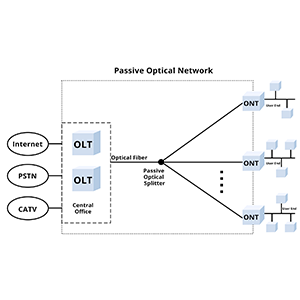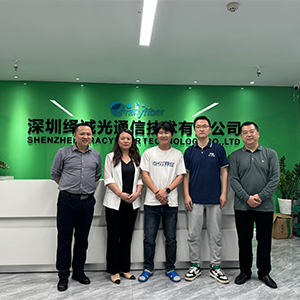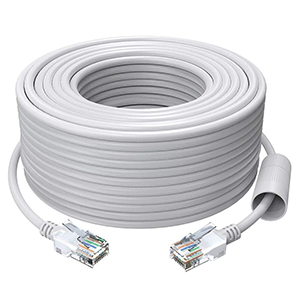Optical amplification technology plays an important role in optical communications. This article will focus on the application of Raman amplifiers in the field of communications. We will first explain the basic physical mechanism of Raman amplification and explain the advantages of Raman amplifiers over other amplifiers. Next, we will deeply analyze the main application scenarios of Raman amplifiers in the field of communications, including long-distance transmission, wavelength division multiplexing systems, non-relay transmission, high-power signal amplification, and multi-wavelength signal amplification.
We will explain the advantages of Raman amplification in these applications and give examples of its use in specific networks. Finally, we will analyze the innovative direction of Raman amplification technology in the network and look forward to the application prospects of Raman amplifiers in future communications.
Raman amplification principle and its advantages
Raman amplifiers use the Raman scattering effect to amplify optical signals and achieve gain by exciting Raman scattered light in optical fibers. Its advantages include: being able to provide uniform gain and reduce signal attenuation in long-distance transmission; adapting to broadband signals and supporting multi-channel communications; and having low requirements for optical fiber transmission, which enhances the flexibility and performance of the system.
1. Basic physical mechanism of Raman amplification
Raman amplification is a light amplification technology based on the Raman scattering effect. Its basic physical mechanism can be summarized as follows:
- Raman scattering effect: When a light beam passes through an optical fiber or other medium, the photons interact with the phonons in the medium, causing the frequency of the photons to change. This phenomenon is called Raman scattering. In Raman scattering, photons exchange energy with phonons in the medium, producing red-shifted or blue-shifted scattered light.
- Excited state and ground state: In Raman scattering, photons can excite phonons in the medium, thereby producing scattered light with a different frequency from the incident light. This frequency difference depends on the material properties of the medium and is usually in the infrared or visible light range.
- Gain medium: In Raman amplification, a specialized gain medium (such as optical fiber doped with Raman-active substances) is used to enhance the optical signal. By injecting strong pump light (usually higher frequency light) into the gain medium, the generated scattered light will propagate in the medium and interact with the signal light, resulting in amplification of the signal light.
- Pump light source: Raman amplification depends on the provision of a pump light source. The pump light source generates the required gain by exciting Raman scattering in the gain medium. The pump light usually has a higher power and a specific wavelength to optimize the amplification effect.
2. Advantages of Raman amplifiers over other amplifiers
Raman amplifiers have the following advantages over other types of optical amplifiers (such as erbium-doped fiber amplifiers, ytterbium-doped fiber amplifiers, etc.):
- Broad gain bandwidth: Raman amplifiers have a wide gain bandwidth and can cover a large spectral range. In contrast, erbium-doped fiber amplifiers have a narrow gain bandwidth and usually only operate around 1550 nm. Raman amplifiers can adapt to the needs of signal amplification at different wavelengths.
- High gain: Raman amplifiers can achieve high gain, especially in long-distance fiber transmission systems. Its gain performance is not limited by the length of the fiber, and effective signal amplification can be achieved in longer fiber segments.
- Flexible amplification configuration: By adjusting the power and wavelength of the pump light, the Raman amplifier can be flexibly configured to adapt to different application requirements. This flexibility makes it suitable for a variety of optical communication systems.
- Low noise characteristics: Raman amplifiers usually have a low noise figure and can provide high-quality signal amplification. This is especially important for long-distance fiber-optic communication systems because noise affects signal clarity and transmission quality.
- Compatible with existing systems: Raman amplifiers can be compatible with existing fiber-optic communication systems, especially when used with existing optical fibers and light sources, reducing the need for system modification.
In general, Raman amplifiers provide flexible, efficient and low-noise amplification solutions in fiber-optic communication systems and are an important part of modern optical communication technology.
Main application scenarios of Raman amplifiers in the field of communications
Raman amplifiers are mainly used in long-distance optical fiber communication systems in the field of communications. They can achieve ultra-long-distance transmission by enhancing signals and reducing attenuation. In addition, they are also used to improve the capacity and performance of optical fiber networks and support high data transmission rates, especially in scenarios with high requirements for signal amplification uniformity and wide bandwidth.
1. Long-distance transmission
Advantages of Raman amplification in long-distance transmission
- High gain: Raman amplifiers can provide high gain in optical fibers, which is particularly important for long-distance transmission. It can effectively compensate for the loss of optical signals in long-distance transmission and improve transmission distance and system performance.
- Low noise characteristics: Raman amplifiers usually have a low noise figure, which reduces the noise interference of the signal and keeps the signal high quality during long-distance transmission.
- Flexible amplification bandwidth: Raman amplifiers can adjust the wavelength and power of pump light to achieve a wide gain bandwidth. This enables effective signal amplification at different wavelengths to meet different fiber transmission requirements.
Application of Raman amplification in submarine and land trunk lines
- Submarine optical cable: In submarine optical cable systems, Raman amplifiers are widely used for ultra-long-distance transmission. Since submarine optical cables are usually very long, traditional erbium-doped fiber amplifiers may not be applicable, and the high gain and low noise characteristics of Raman amplifiers make them an ideal choice. For example, Raman amplifiers in submarine optical cables can achieve ultra-long-distance transmission of thousands of kilometers through multiple amplification sections.
- Land trunk lines: In land optical fiber trunk lines, Raman amplifiers are used to enhance signal transmission distance and bandwidth. Similar to submarine optical cables, long-distance transmission of land trunk lines also requires high-gain, low-noise amplifiers to ensure signal quality. Raman amplifiers can be used in conjunction with erbium-doped fiber amplifiers to improve the overall performance of the system.
2. Wavelength Division Multiplexing System
The role of Raman amplification in DWDM systems
- DWDM system (dense wavelength division multiplexing): Raman amplifiers play an important role in DWDM systems. DWDM systems combine multiple wavelengths of optical signals in the same optical fiber for transmission, and each wavelength signal requires independent amplification. In DWDM systems, Raman amplifiers can provide uniform gain for multiple wavelength signals, avoiding the limitations of single wavelength amplifiers and achieving efficient multi-channel signal amplification.
Application of Raman Amplification in CWDM and Other Systems
- CWDM System (Coarse Wavelength Division Multiplexing): The wavelength interval of CWDM system is large, and the gain bandwidth requirement is relatively wide. The wide gain bandwidth of Raman amplifier makes it advantageous in CWDM system. It can effectively amplify in a wide wavelength range to meet the multi-wavelength signal transmission requirements of CWDM system.
3. Relayless Transmission
Advantages of Raman Amplification in Relayless Transmission
- Reducing the Need for Relay Stations: Relayless transmission (i.e. direct long-distance transmission) relies on efficient amplifier technology. The high gain characteristics of Raman amplifiers make it possible to reduce the number of relay stations in long-distance transmission. By embedding Raman amplifiers in optical fibers, long-distance, non-relay optical signal transmission can be achieved in a single optical fiber segment.
Application of Raman Amplification in Relayless Optical Networks
- Long-distance Backbone Networks: In some long-distance optical fiber backbone networks, Raman amplifiers are used to achieve long-distance transmission without relays. This application can reduce the construction and maintenance costs of relay stations while improving the reliability and stability of the network.
4. High-power Signal Amplification
Application of Raman Amplification in High-power Signal Amplification
- High-power Applications: In applications that require high-power output, such as high-power optical communications and fiber lasers, Raman amplifiers can provide high-power signal amplification. Raman amplifiers can achieve high-power amplification by increasing the power of pump light, which is necessary for high-power fiber communication systems and lasers.
Use of Raman Amplification in Fiber Lasers
- Fiber Lasers: Raman amplifiers are used as high-power amplifiers in fiber lasers to enhance the output power of fiber lasers. By combining Raman amplifiers with fiber lasers, high-power laser output can be achieved to meet the needs of various industrial and scientific research applications.
5. Multi-wavelength Signal Amplification
Advantages of Raman Amplification in Multi-wavelength Signal Amplification
- Wide Gain Bandwidth: The wide gain bandwidth of Raman amplifiers makes them perform well in multi-wavelength signal amplification. It can evenly amplify optical signals of multiple wavelengths, avoiding the limitations of single-wavelength amplifiers in multi-wavelength applications.
Application of Raman Amplification in Multi-channel Transmission Systems
- Multi-channel Transmission Systems: In multi-channel transmission systems, Raman amplifiers can effectively amplify multiple signal wavelengths at the same time. This feature makes it suitable for communication systems that need to process multiple wavelength signals simultaneously, such as multi-wavelength transmission networks and optical fiber communication links. By integrating Raman amplifiers in the system, the transmission capacity and system performance can be improved.
Development Trends of Raman Amplifiers in Communication Networks
The development trends of Raman amplifiers in communication networks include: the development towards higher gain and wider bandwidth to support higher speed and larger capacity network requirements; the increasing number of integrated designs to reduce cost and complexity; and the combination with other advanced technologies such as spectrum control and nonlinear optical fiber technology to further improve system performance and flexibility.
1. Innovative directions of Raman amplification technology in the network
1.1 Integration and miniaturization
- Integrated optical chips: With the development of optoelectronic technology, integrated optical chips have become an emerging innovative direction for Raman amplifiers. These chips integrate Raman amplifier functions into a single photonic integrated circuit, reducing the size and cost while improving the reliability and stability of the system.
- Micro-fiber devices: Miniaturized fiber devices, such as micro-fiber amplifiers, can embed Raman amplification functions into small devices. These micro-devices can provide efficient optical signal amplification in a compact space and are suitable for high-density integrated systems and miniaturized applications.
1.2 High power and wide bandwidth
- High-power Raman amplification: Future Raman amplification technology will further increase power output to meet the needs of high-power communication systems and fiber lasers. By optimizing the pump light source and gain medium, researchers are committed to achieving higher power levels and adapting to larger-scale application scenarios.
- Wide bandwidth amplification: The gain bandwidth of Raman amplifiers continues to expand to adapt to a wider spectral range. Wide-bandwidth Raman amplifiers can support a wider range of wavelength division multiplexing systems, including higher-density DWDM and CWDM systems, improving the transmission capacity and flexibility of the network.
1.3 Intelligent and adaptive technology
- Intelligent control system: Intelligent control systemSystems will become an important development direction for Raman amplifiers. These systems can monitor the network status in real time and automatically adjust the parameters of the amplifier (such as pump power and gain bandwidth) to optimize network performance and stability.
- Adaptive gain adjustment: Future Raman amplifiers will have adaptive gain adjustment function, which can automatically adjust the gain according to the real-time signal strength and transmission conditions. This will improve the adaptability and efficiency of the amplifier under different network conditions.
1.4 New materials and technologies
- New gain media: Researchers are exploring new gain media, such as new fiber materials and nanostructured materials, to improve the performance of Raman amplifiers. These new materials may bring higher gain, lower noise and wider gain bandwidth.
- Photonic crystal fiber: As a new type of fiber material, photonic crystal fiber has unique optical properties and may become a key material in Raman amplifiers. Photonic crystal fibers can support higher nonlinear effects, thus achieving more efficient Raman amplification.
2. Application prospects of Raman amplifiers in future communications
2.1 Next-generation optical communication networks
- Ultra-high-speed communications: As the demand for higher data transmission rates increases, Raman amplifiers will play an important role in the next-generation optical communication networks. Their high gain and wide bandwidth characteristics enable them to support ultra-high-speed data transmission, meeting the needs of large-capacity data centers and long-distance backbone networks.
- Intelligent optical networks: Future optical communication networks will be more intelligent, and the adaptive and intelligent control technology of Raman amplifiers will enable them to work closely with intelligent optical network systems to optimize the allocation and use of network resources and improve overall network performance.
2.2 5G and future 6G communications
- 5G and 6G infrastructure: In 5G and future 6G communication networks, Raman amplifiers will serve as efficient signal amplifiers to support large-scale wireless communications and data transmission. Their high power and wide bandwidth characteristics make them suitable for infrastructure construction of these new generation communication systems.
- High-frequency communication: With the further expansion of spectrum resources, Raman amplifiers will be applied to optical communication systems in higher frequency bands, such as optical communication in the terahertz band. Its high-frequency adaptability will enable it to support the needs of future communication technologies.
2.3 Global Internet and Submarine Cables
- Global Internet Backbone: Raman amplifiers have broad application prospects in the global Internet backbone. Their high gain and low noise characteristics enable them to support long-distance intercontinental fiber transmission, improving the transmission capacity and stability of the global Internet.
- Submarine Cable Systems: Future submarine cable systems will continue to rely on the high performance of Raman amplifiers. As the length and complexity of submarine cables increase, Raman amplifiers can effectively support ultra-long-distance high-capacity data transmission, promoting the further development of global communication networks.
2.4 High-Performance Computing and Big Data Processing
- Data Center Interconnection: In high-performance interconnection between data centers, Raman amplifiers will provide efficient optical communication solutions for big data processing. Its high bandwidth and low latency characteristics will support high-speed data transmission and processing, meeting the needs of the big data era.
- Computer Networks: Future computer networks will require higher bandwidth and lower latency, and the application of Raman amplifiers will help achieve these goals. By providing efficient signal amplification, Raman amplifiers can support the needs of high-performance computing and real-time data processing.
In short, Raman amplifiers have broad application prospects in future communication networks, and their technological innovation and development will promote the improvement of communication network performance and meet the growing demand for data transmission.
Summary
Raman amplifiers are one of the key components for building high-performance optical communication networks. Our company has long focused on the research and development and application of optical amplification technology and has rich practical experience. We provide various high-performance Raman amplifier products that can be widely used in long-distance optical fiber communications, metro networks, data center interconnection and other fields.
Our Raman amplifiers use advanced manufacturing processes and have excellent optical performance and reliability, which can effectively support the high-speed transmission and large-capacity requirements of the network. At the same time, our team of engineers will provide you with professional system integration services to ensure that the Raman amplifier performs at its best in practical applications. Contact us now to learn more. We will do our best to provide you with the best quality products and solutions.
Telecom Raman Amplifiers FAQ
A Telecom Raman Amplifier is an optical amplifier used in telecommunications networks that utilizes Raman scattering in optical fibers to amplify the signal light. It is designed to enhance signal transmission over long distances.
It works by using a high-power pump laser to generate Raman scattering in the fiber. The energy from the pump laser is transferred to the signal light, resulting in amplification of the optical signal.
Advantages include wide wavelength coverage, flexible gain bandwidth, and the ability to be used in distributed amplification scenarios. This helps to extend the reach of telecom networks and improve signal quality.
Key components include the Raman pump laser, the Raman gain fiber (often a standard single-mode fiber), optical isolators, and sometimes wavelength division multiplexing (WDM) components for combining signals and pumps.
Raman amplifiers use nonlinear Raman scattering in fibers and can cover a broader wavelength range, while EDFAs use erbium-doped fibers and are typically optimized for the C-band and L-band of the optical spectrum.
They are used in long-haul and ultra-long-haul optical communication systems, wavelength division multiplexing (WDM) networks, and to enhance signal strength and quality over long distances.
Challenges include managing the high power requirements for pump lasers, controlling Raman gain and noise, and ensuring effective dispersion management and system integration.
They improve network performance by increasing the reach and capacity of optical networks, reducing the need for repeaters, and enhancing the signal-to-noise ratio over long distances.
Telecom Raman Amplifiers typically cover a broad wavelength range, often from 1300 nm to 1700 nm, making them suitable for amplifying signals across multiple WDM channels.
Performance is measured by parameters such as gain, noise figure, pump power efficiency, wavelength coverage, and gain flatness. Testing involves evaluating how effectively the amplifier boosts the signal while minimizing noise and distortion.




